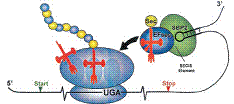Biochemistry, Department of

Vadim Gladyshev Publications
Document Type
Article
Date of this Version
April 2005
Abstract
Co-translational insertion of selenocysteine (Sec) into proteins in response to UGA codons is directed by selenocysteine insertion sequence (SECIS) elements. In known bacterial selenoprotein genes, SECIS elements are located in the coding regions immediately downstream of UGA codons. Here, we report that a distant SECIS element can also function in Sec insertion in bacteria provided that it is spatially close to the UGA codon. We expressed a mammalian phospholipid hydroperoxide glutathione peroxidase in Escherichia coli from a construct in which a natural E.coli SECIS element was located in the 3’-untranslated region (3’-UTR) and adjacent to a sequence complementary to the region downstream of the Sec UGA codon. Although the major readthrough event at the UGA codon was insertion of tryptophan, Sec was also incorporated and its insertion was dependent on the functional SECIS element in the UTR, base-pairing potential of the SECIS flanking region and the Sec UGA codon. These data provide important implications into evolution of SECIS elements and development of a system for heterologous expression of selenoproteins and show that in addition to the primary sequence arrangement between UGA codons and SECIS elements, their proximity within the tertiary structure can support Sec insertion in bacteria.


Comments
Published by Nucleic Acids Research, 2005, Vol. 33, No. 8. © The Author 2005. Published by Oxford University Press. Permission to use.